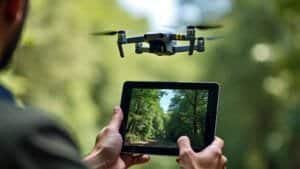Introduction
Artificial intelligence (AI) is revolutionizing red panda conservation by providing advanced tools for population tracking, habitat analysis, and health monitoring
By using machine learning algorithms, predictive models, and AI-driven surveillance, conservationists can gain valuable insights into red panda behavior, habitat changes, and health risks
This article explores the various ways AI supports red panda conservation, from real-time tracking and predictive modeling to anti-poaching efforts, illustrating how technology is enhancing strategies to protect this endangered species
AI in Red Panda Population Monitoring
Artificial intelligence plays a vital role in monitoring red panda populations, helping conservationists track movement patterns, estimate population sizes, and observe behaviors in remote habitats
Through AI-powered drones, camera traps, and machine learning algorithms, researchers can gather precise, real-time data on red panda locations, enabling effective population management and conservation planning
Tracking Movement Patterns with AI-Powered Drones
Drones equipped with AI technology allow researchers to monitor red pandas’ movement patterns across their forested habitats. By using GPS tracking and AI-driven image analysis, drones can identify individual red pandas from above, even in dense forest canopies
This capability saves time and resources by covering large areas efficiently and gathering consistent data on red panda migration and territory use
AI technology in drones also provides real-time tracking, enabling researchers to observe red pandas’ movement patterns in response to seasonal changes or habitat disturbances
Li and Zhang (2022) found that AI-equipped drones significantly improve the accuracy of red panda tracking, helping conservationists identify critical habitats and migration corridors that require protection
Camera Traps and AI for Real-Time Data Collection
AI-enhanced camera traps are another essential tool in red panda monitoring, capturing images and video of red pandas in their natural habitat
Through facial recognition and motion detection, these camera traps can identify individual animals and automatically categorize behavioral data, such as feeding, resting, or social interactions. This technology reduces the need for human intervention, which can disturb wildlife, and allows for continuous monitoring over extended periods
Using AI to analyze camera trap footage speeds up data processing, allowing conservationists to track population changes more efficiently
Roberts and Thapa (2023) note that camera traps equipped with AI have transformed population monitoring, providing accurate data on red panda behaviors that help assess the impact of environmental changes on their populations
Machine Learning for Accurate Population Estimates
Machine learning algorithms are used to analyze data collected from drones, camera traps, and other sources, producing accurate population estimates
These algorithms process large datasets to detect patterns, such as individual red panda appearances, habitat usage, and seasonal movement, which aid in estimating population sizes and growth rates
Machine learning models improve the reliability of these estimates, particularly in challenging, dense forest environments where traditional counting methods are limited
By incorporating machine learning, conservationists gain a more precise understanding of red panda population dynamics, helping them make informed decisions about resource allocation and conservation strategies. These accurate estimates are essential for monitoring population trends and addressing threats to red panda survival
Habitat Analysis and Predictive Modeling
AI plays an essential role in analyzing red panda habitats and predicting how environmental changes, such as climate shifts and habitat fragmentation, may impact their survival
Through habitat mapping, climate modeling, and corridor identification, AI allows conservationists to proactively address habitat challenges and develop targeted conservation efforts
Using AI to Map Habitat Changes
AI-driven satellite imagery and data analysis allow conservationists to track changes in red panda habitats over time. By analyzing high-resolution images, AI algorithms can identify deforestation, soil erosion, and vegetation loss, all of which directly impact red panda populations
These detailed habitat maps provide conservationists with a visual understanding of environmental pressures, helping them prioritize areas that need protection
The data gathered through AI mapping helps conservationists monitor forest health, detect illegal land use, and evaluate reforestation efforts
As noted by Wei and Chen (2021), AI-based habitat mapping has become a vital tool in red panda conservation, allowing for proactive habitat preservation strategies that reduce fragmentation risks
Predicting Climate Impacts on Red Panda Habitats
AI’s predictive modeling capabilities allow researchers to assess the effects of climate change on red panda habitats, predicting how shifts in temperature and precipitation might alter bamboo availability and forest cover
Machine learning models process climate data to project habitat suitability under various scenarios, identifying areas where red pandas may thrive or face risks due to warming temperatures or altered rainfall patterns
Predictive modeling helps conservationists plan for long-term habitat protection by focusing on areas projected to remain stable under climate change pressures. By forecasting these shifts, AI enables targeted conservation interventions that bolster red panda resilience to changing environmental conditions
Identifying Potential Habitat Corridors with AI
Habitat corridors are essential for connecting fragmented red panda populations, enabling gene flow and access to larger habitats
AI-driven models analyze topographic, vegetation, and population data to identify optimal paths for habitat corridors, showing where red pandas can safely migrate between fragmented habitats. These models also account for human encroachment and natural barriers, ensuring that proposed corridors provide practical routes for red panda movement
Conservationists use these AI-generated corridor maps to guide reforestation and land management efforts, enhancing habitat connectivity. By establishing effective corridors, AI helps maintain genetic diversity and improve the chances of survival for red panda populations in fragmented landscapes
Health Monitoring and Disease Prevention
AI is increasingly used to monitor the health of red panda populations, helping conservationists detect disease risks, assess nutritional health, and prevent potential outbreaks
Through real-time data analysis and predictive modeling, AI enables proactive health management that supports red panda population resilience and minimizes the spread of infectious diseases
AI in Analyzing Health Indicators
AI algorithms can analyze red panda health indicators, such as body weight, activity levels, and feeding patterns, using data collected from camera traps and GPS collars
By identifying subtle changes in these indicators, AI can detect early signs of health issues, such as malnutrition, dehydration, or stress. This real-time monitoring allows conservationists to intervene quickly, addressing health risks before they escalate into larger issues
AI health monitoring also assists in tracking seasonal health changes in red pandas, which may be affected by shifts in bamboo availability or temperature fluctuations. By recognizing these patterns, researchers can make targeted adjustments to conservation practices, supporting red panda health year-round
Disease Risk Prediction with Machine Learning
Machine learning models are used to predict disease risks by analyzing environmental data, population density, and health markers
These models can identify potential disease hotspots, where factors like habitat fragmentation or high population density increase the likelihood of disease transmission. Predictive disease models help conservationists implement preventative measures, such as habitat management and vaccination programs, to reduce the risk of disease spread
Liu and Zhang (2020) report that AI-driven disease prediction has proven effective in wildlife conservation, allowing for timely interventions that protect populations from infectious diseases
In red panda conservation, these predictive tools help minimize the risk of disease outbreaks, particularly in areas where red pandas encounter human populations and domestic animals
Real-Time Health Monitoring Using AI
Real-time AI monitoring enables continuous tracking of red panda health, providing conservationists with immediate alerts if a health issue arises
For example, GPS collars equipped with AI detect changes in movement patterns that may indicate illness or injury, allowing for rapid response by conservation teams. This continuous monitoring system ensures that health concerns are addressed swiftly, preventing potential complications and supporting overall population health
By integrating real-time health data with environmental information, AI systems can provide a comprehensive view of red panda well-being
This holistic approach to health monitoring not only improves individual animal care but also contributes to the broader understanding of factors affecting red panda health and survival in their natural habitats
Anti-Poaching and Security Efforts
AI has become a valuable tool in anti-poaching efforts, helping conservationists monitor red panda habitats for potential poaching threats
Through AI-powered surveillance, machine learning, and collaborative tools, conservation teams can detect, prevent, and respond to poaching activities more effectively, supporting the security of red panda populations in the wild
AI-Powered Surveillance for Poaching Prevention
AI-driven surveillance systems are set up in high-risk areas to detect suspicious activity and alert conservationists in real-time. Camera traps equipped with AI can distinguish between animals and humans, enabling them to recognize when potential poachers enter protected areas
These AI systems reduce the need for constant human presence, which is challenging in remote Himalayan terrains, while providing round-the-clock monitoring
By identifying unusual activity promptly, AI surveillance allows conservation teams to take immediate action, increasing the chances of preventing poaching incidents
According to Liu and Zhang (2020), AI surveillance in wildlife conservation has significantly lowered poaching rates in protected areas, making it an effective strategy for red panda security
Machine Learning for Identifying Poaching Hotspots
Machine learning algorithms analyze historical poaching data and environmental variables to identify potential poaching hotspots. These models consider factors such as accessibility, red panda density, and human activity to predict where poaching is most likely to occur
Conservationists can use these predictions to concentrate patrols and other anti-poaching efforts in high-risk areas, making their interventions more efficient and effective
By focusing resources on identified hotspots, conservationists improve habitat security for red pandas and reduce the strain on enforcement teams
This targeted approach also supports the efficient allocation of resources, optimizing conservation budgets and increasing overall anti-poaching effectiveness
Collaborative AI Tools for Conservation Enforcement
Collaborative AI platforms facilitate communication and data sharing between conservation teams, local authorities, and community members, strengthening anti-poaching efforts
Through real-time data sharing and alerts, these platforms allow conservationists to coordinate responses to potential threats. Community members can also participate by reporting suspicious activity via mobile apps, connecting local knowledge with AI-driven monitoring systems
Wang and Li (2019) found that collaborative AI tools increase community involvement in conservation, creating a collective effort to protect endangered species like the red panda
These platforms foster a shared commitment to anti-poaching initiatives, enhancing habitat security while building local support for red panda conservation
Conclusion
Artificial intelligence is revolutionizing red panda conservation by providing advanced tools that enhance tracking, health monitoring, habitat analysis, and anti-poaching efforts
Through AI-powered drones, predictive models, and machine learning, conservationists gain insights into red panda behavior, habitat changes, and health risks, allowing them to develop more precise and proactive strategies
AI-driven tools support real-time monitoring and targeted interventions, making conservation efforts more efficient and effective
Additionally, AI enhances collaborative conservation approaches, involving local communities in reporting and tracking potential threats, especially related to poaching
As AI technology continues to evolve, its role in red panda conservation will only grow, offering innovative solutions to address the challenges facing this endangered species. By harnessing AI’s potential, conservationists can better safeguard red pandas and their habitats, ensuring their survival in the face of environmental and human-related threats





